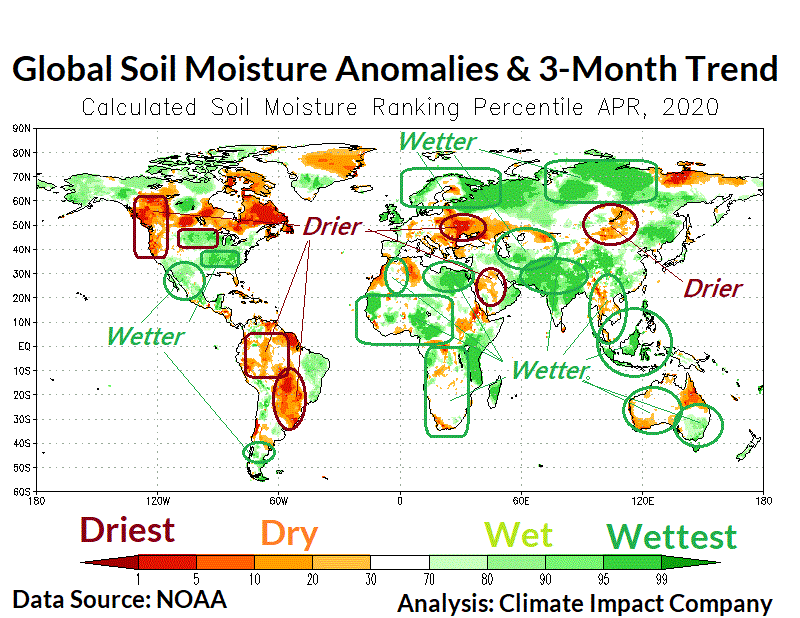The U.S. Population Weight HDD Anomalies for the 2019-20 Cold Season
05/03/2020, 12:37 pm EDTWeak La Nina Likely During Tropical Cyclone Season
05/10/2020, 9:48 am EDT
Fig. 1: The NOAA/CPC soil moisture ranking percentile valid April 2020 with Climate Impact Company annotated 3-month trend.
Observation discussion: Climate Impact Company has provided the 3-month soil moisture anomaly trend of the NOAA/CPC monthly global soil moisture analysis (Fig. 1) for MANY years. RARELY is the number of regions trending wetter over the past 3 months outnumbering the drier changes. However, due to the anomalous warm oceans (Fig. 2) – especially in the middle latitudes in recent years, this monthly product has trended wetter and April 2020 is no exception. The analysis reveals 15 wetter regions compared to just 6 drier regions.
Despite the large amount of wet soil regions there are some important drought areas. The strongest dry area emerging is across southwest Brazil’s second corn crop and extending across the Parana River basin. This zone trended much drier the past 2-3 months. A second key drought area is across the south and southwest Russia wheat belt extending to Romania also trending drier through early 2020 (but receiving rainfall in early May). Drought in the Northwest U.S. and southwestern Canada is strengthening. Central and East Canada drought continues.
Elsewhere droughts are fading including Southeast Asia and Australia thanks to slow changes in El Nino southern oscillation (ENSO) and evolution of negative Indian Ocean Dipole (-IOD).
The wet zones are profound! A diminished ice cap north of Russia leaving a swath of open ocean water off the northwest coast provides a wet fetch to leave most of northern Russia with very wet soils. Last years’ strongest wet monsoon on record leaves India soil moisture soaking wet. South Africa drought has faded and the western African tropics have also turned wetter. The West Africa tropics are a source region for tropical waves as North Atlantic tropical cyclone season approaches.
In the U.S. the very wet soil moisture signature in the North-central to Midwest States is reversing drier but the Mid-South U.S. 2020 heavy rain pattern has caused wetter soil moisture changes there. Northern Mexico has trended somewhat wetter the past several months. In South America parts of southern Chile have trended much wetter while a decadal drought remains in-place for central and northern Chile. South-central Argentina was wetter through April.

Fig. 2: The NCDC/PSD 30-day global SSTA analysis valid May 2, 2020.
![Climate-Impact-Company-logo-sm[1]](https://climateimpactcompany.com/wp-content/uploads/2023/08/Climate-Impact-Company-logo-sm1.png)
